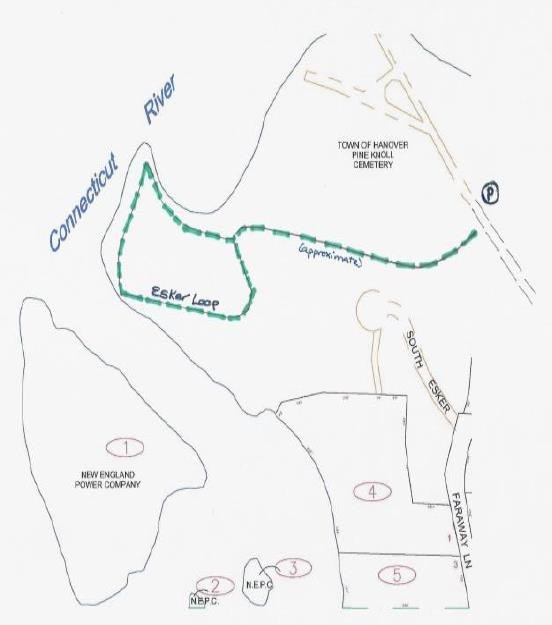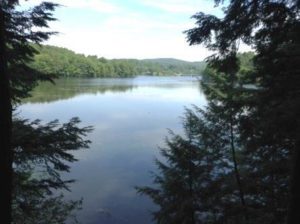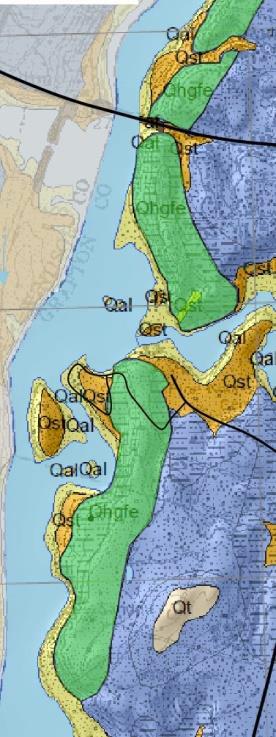South Esker Hike – Full PDF
 Driving Directions
Driving Directions
- From downtown Hanover, drive south on Main Street for 0.5 miles
- Just after crossing the bridge over Mink Brook, turn right at 121 South Main Street, for the Pine Knoll Cemetery and Water Reclamation Facility
- Drive through the gate and continue 0.3 miles through the cemetery, staying left at a fork in the lane.
- The trailhead appears on the left, marked with a blue sign. Park your car just a few yards beyond on the right (not in the maintenance area on the left).
What You Should Know
- Foot travel only. Dogs are welcome but must be under close control; please pick up after your pet.
- The trails are well-blazed in town colors: two white patches on either side of a blue patch.
- Pack a picnic to enjoy by the water, but remember that camping and fires are not permitted.
- The Town of Hanover owns and manages the South Esker. When an 8-lot housing development was proposed for this entire forested hillside, a couple purchased the 17-acre property, built their home on four acres, and sold the remainder to the Town in 1971. The Hanover Conservancy (then known as the Hanover Conservation Council) had acquired an option on the land the previous year and raised the funds for the purchase.
Hiking Directions
- Step onto the trail from the paved lane and watch your feet – almost the first step is, disconcertingly, onto a sewer manhole cover. Disconcerting, that is, until you remember that the nearby water reclamation facility works round the clock to clean Hanover’s wastewater before it is released into the Connecticut River. In the dirty old days before the Clean Water Act, before this facility was built, Mink Brook carried raw sewage from many hundreds of homes right past this spot. Enough of that – let’s get into the clean, cool woods!
- Shortly after entering the woods, note the distinctive blue and white blaze at a fork in the trail. Stay right to follow the blazes as the trail begins to gently climb and then slabs along the side of the hill heading west.
- At about 6 minutes from your car, arrive at a double blaze on a big hemlock tree and a new trail sign indicating the Esker Loop. This is your destination.
- Continue straight to follow the loop counter-clockwise.
- The reliable blazes make the path easy to follow despite the lack of understory plants and a defined treadway. Soft needles fallen from the pines and hemlocks overhead blanket the forest floor and muffle your steps while imparting a sweetly woodsy scent to the air.
- After three or four minutes, an arrow directs you to turn left. But if you’re curious, continue on a few paces to a screened view over the round settling ponds of the water reclamation facility below.
- Retrace your steps to the arrow.
 Head down the hill toward a quiet cove on the river shore. The small but delightful viewpoint here, where soil conditions hint that many others have stopped here before you, is a peaceful spot to glimpse the Ledyard Bridge in the distance. Ducks and other waterfowl linger in the quiet water below. If you have a dog or small children with you, be sure they don’t stray too close to the edge of the steep, high bank.
Head down the hill toward a quiet cove on the river shore. The small but delightful viewpoint here, where soil conditions hint that many others have stopped here before you, is a peaceful spot to glimpse the Ledyard Bridge in the distance. Ducks and other waterfowl linger in the quiet water below. If you have a dog or small children with you, be sure they don’t stray too close to the edge of the steep, high bank.- A side trail comes in from the left as you proceed gradually bearing right following the white/blue blazes and the curving riverbank.
- 20 minutes from your car, the trail reaches a sharp point jutting out into the river that offers another view of both Ledyard Bridge, screened by the branches of some brave young hemlocks, and on the right, the wastewater treatment plant. Stop for a moment to take in the scene. We’ve already imagined what the brook and river might have been like on a warm summer day before 1970 and the Clean Water Act (when a riverfront home was not desirable). Now imagine how this area might have appeared before 1950, when Wilder Dam, less than two miles downstream, inundated this area. Mink Brook would have met a much narrower Connecticut River mainstem and would be a small stream itself here. Many years before that, Abenaki dwellings and other landmarks of Native life would have stood here at the confluence of such a significant stream. Today, these places are submerged.
- Now follow the trail as it turns south and follows some quiet water that separates the land from Gilman Island. Keep an eye out for an odd hardwood tree that reminds you of sinewy muscles – this is American hornbeam, also called musclewood, ironwood, blue beech, or water beech. It is often found in the understory of forests along rivers and streams where it can withstand periodic flooding. Its hard wood was used to make tool handles and mallet heads.
- 25 minutes from your car, arrive at your picnic spot next to the river. On a hot day, a swim might be fun. Indeed, water quality has improved so much over the last 45 years that the river is clean enough for swimming, although it’s always wise to avoid the river after a very heavy storm.
 Gilman Island, a bedrock outcropping in the river, stands just across this short stretch of water. Owned by Great River Hydro and the westernmost point in Hanover, the island is a great camping destination for river trippers. Two campsites on the south side each have room for 10 campers. In 2015, a mouldering privy was installed in a partnership project between the Vermont River Conservancy, Dartmouth College, and LL Bean, with support from the previous hydro company, TransCanada, and the Silvio Conte Fish and Wildlife Refuge. On the island’s north end stands Dartmouth’s Titcomb Cabin. Originally built in 1953, it burned down in 2009. Dartmouth students took on the challenge of rebuilding the log cabin on the old site, and it is available for rent.
Gilman Island, a bedrock outcropping in the river, stands just across this short stretch of water. Owned by Great River Hydro and the westernmost point in Hanover, the island is a great camping destination for river trippers. Two campsites on the south side each have room for 10 campers. In 2015, a mouldering privy was installed in a partnership project between the Vermont River Conservancy, Dartmouth College, and LL Bean, with support from the previous hydro company, TransCanada, and the Silvio Conte Fish and Wildlife Refuge. On the island’s north end stands Dartmouth’s Titcomb Cabin. Originally built in 1953, it burned down in 2009. Dartmouth students took on the challenge of rebuilding the log cabin on the old site, and it is available for rent.- There’s more to see on the way back to your car. Follow the white/blue blazes as they lead southeast and away from the water. You enter a pine and hemlock forest that, while younger and denser than what you walked through earlier, still retains that quiet and dignified “cathedral” feel. Forest studies by the Hanover Conservancy indicate that the area was open at some point, likely for pasture of cattle or other livestock. Increment borings of the largest hemlock go back to the year 1904.
- Soon, the esker itself looms up before you as the trail bears left at its foot. This steep-sided deposit of sand and gravel marks the path of a river that once flowed under the glacier. This esker follows the current path of the Connecticut River for many miles.
- On your left, the forest floor is suddenly green with a carpet of ferns and other growth, where water flowing down the slope pools before sinking into the soil.
- 10 minutes from the picnic spot, the river appears again through the trees and you reach a trail junction. Turn right up hill. At the top, turn right again.
- 15 minutes from the picnic spot, you’ll return to the brown sign and know you’ve completed the Esker Loop. Continue straight, still following blazes.
- Soon you’ll encounter a trail junction you may not have noticed on the way in – a short path to the right leads to a driveway off Spencer Road. Bear left instead and take the now-familiar trail as it slabs across and down the hill, delivering you back to your car.

Left: green indicates the esker along the river; blue indicates sediments deposited later by glacial Lake Hitchcock. The yellow arrow indicates the South Esker Natural Area.
Esker map modified from the Surface Geologic Map of the Hanover Quadrangle Grafton County, NH by Carol T. Hildreth, NH Geological Survey Surficial Geologic Map Series GEO-091-024000-SMAP. Thanks to Carl Renshaw, formerly of the Hanover Conservancy Board of Directors.




